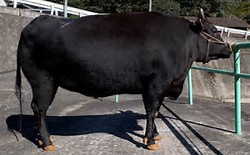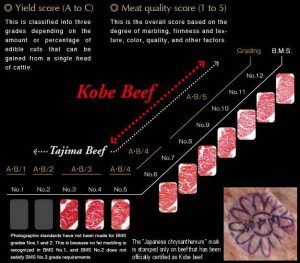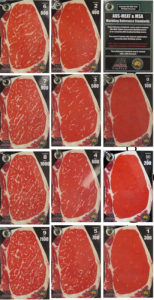Waygu Beef And Kobe Beef – What’s The Difference?
Many people get confused and are fed mis-information about Wagyu Beef and Kobe Beef. So what is the difference?
Wagyu simply means “Japanese cow”. There are of several breeds of Waygu cattle including, Japanese Black, Japanese Brown, Japanese Poll, and Japanese Shorthorn. Each have Ox-like structure and were originally bred for field work within the Japanese agricultural industry many years ago.
Over time and through natural genetically breeding programs and feeding techniques, the breed was found to have intense marbling and able to produce a high percentage of oleaginous unsaturated fat. The marbled meat with softer fat, has higher percentages of monounsaturated fats, omega-3 and omega-6 fatty acids and is lower in cholesterol than normal commodity beef. The animals where sometimes massaged and the adding of beer or sake to the animals diet also became great marketing tools to get people interested in the breed and meat eating quality. It is believed that the beer and sake helps digestion with the high grain cereals diet. The beer or sake is fed at a certain time of the day and I have seen in person Wagyu cattle given beer and they all rush to have a drink as they love it.
intense marbling and able to produce a high percentage of oleaginous unsaturated fat. The marbled meat with softer fat, has higher percentages of monounsaturated fats, omega-3 and omega-6 fatty acids and is lower in cholesterol than normal commodity beef. The animals where sometimes massaged and the adding of beer or sake to the animals diet also became great marketing tools to get people interested in the breed and meat eating quality. It is believed that the beer and sake helps digestion with the high grain cereals diet. The beer or sake is fed at a certain time of the day and I have seen in person Wagyu cattle given beer and they all rush to have a drink as they love it.
The meat from such Wagyu cattle is known for its quality, consistent marbling factor and flavour which is highly sort by top line restaurants and meat connoisseur World wide. Waygu beef has the most desirable taste, delivering rich and tender flavour compared to other beef.
So what about Kobe Beef?
Quite simply, Kobe Beef is the name of the actual area in Japan where that particular Waygu Beef comes from. Wagyu beef from certain areas in Japan are shipped carrying the area names. Some examples are Kobe, Mishima, Matsusaka, Kuchinoshima,
So Kobe beef is a branding and marketing strategy that is being used to give the Waygu beef from that area a clever advantage by promoting the uniqueness of the Kobe area and help increase the pricing.
To be called Kobe beef legitimately there has been a specific standard set up by the Kobe Beef Marketing and Distribution Promotion Association. The standards and requirements are…
- Tajima cattle born in Hyōgo Prefecture

- Farm feeding in Hyōgo Prefecture
- Bullock (steer or castrated bull)
- Processed at slaughterhouses in Kobe, Nishinomiya, Sanda, Kakogawa, or Himeji in Hyōgo Prefecture
- Marbling ratio, called BMS, of level 6 and above[11]
- Meat quality score of 4 or 5[11]
- Gross weight of beef from one animal is 470 kg or less.
From Wikipedia
So now you know the difference, let me explain more about Waygu Beef…
Waygu beef is now bred throughout the World but the main countries that produce great quality are Japan, USA and Australia with many others starting to break into the industry.
Waygu beef is regarded as the best of the best when it comes to describing meat taste experience. Why? It all has to do with the marbling content within the meat or steak.
What does marbled meat mean? Marbled meat is meat, that contains various amounts of intramuscular fat, giving it an appearance similar to a marble pattern. Now, the fat is what helps generate the great flavours within the meat but it also allows the meat to become tenderer than normal meat.
How can this be so? Think of it this way. When there is fat within a steak, and you start to cook the steak, fat will naturally melt away from the meat. This process creates gaps within the meat fibres of the steak. Now that there is more room and space between these meat fibres, the steak structure is softer hence becoming tender. The added uniqueness of Waygu beef is that the melting point of Waygu fat is lower than normal beef fat making cooking time less and allowing more juices to stay within the steak giving that unique flavour taste experience.
naturally melt away from the meat. This process creates gaps within the meat fibres of the steak. Now that there is more room and space between these meat fibres, the steak structure is softer hence becoming tender. The added uniqueness of Waygu beef is that the melting point of Waygu fat is lower than normal beef fat making cooking time less and allowing more juices to stay within the steak giving that unique flavour taste experience.
You may have seen in butcher shops or restaurants that the pricing of Waygu meat or meat in general varies by some extremes. The reason for this is that the grading of meats are some times determined by Marbling Grades.
The marble grading standards vary from country to country and below are the standards for Japan, USA and Australia.
As mentioned above in Japan to be classified as Kobe Waygu Beef a standard must be adhered to. One of the requirements for Kobe Beef is that the meat is stamped with an official seal in ink of the “Japanese Chrysanthemum”. The seal stamp is placed on the fat of the carcass in various positions on the carcass. The marbling grade is given by a score from a Beef Marbling Standard guide. BMS for short.
Japanese also use a Meat Quality Score by four factors: marbling, colour and brightness, firmness and texture, and fat colour, lustre and quality. Each factor is graded by number with the highest number score being of best quality and standard.

Japanese Marbling Chart
In the USA the grading standard used is called BMS as well and is used by giving score rating to red beef for the amount of intramuscular flecks of fat within the meat. The score rating is described by numbers form 1 to 12 with the highest number being regarded as the best quality and standard. Also demanding a greater price.
The USDA scale for upper grade meat quality has 3 levels: Select, Choice, and Prime. Prime is the highest USDA grade and some Wagyu US cattle are harvested and graded as Prime with an equivalent Wagyu BMS score of 5 and higher.

USDA BMS Marbling Scale
The Australian marble scoring range is from 1 to 9 +. A little different from Japanese and the USDA grading systems. Australia has its own grading system called MSA (Meat StandardsAustralia) is well known around the World. Australia’s MSA grading system is quite comprehensive and a piece of meat can be traced right back to the farm and actual animal that it was produced from.

As you can see the charts are all quite similar in what the information each country is wanting to gather so they are able to maintain a basic quality standard across the Worlds markets.
Next question….
Where can I get Waygu Beef On-line?
There are various on-line stores where Waygu is available for home delivery and I have found an on-line company that deliver great quality Waygu beef right to your door. They are…
Snake River Farms (SRF)
Snake River Farmers and Double R Ranch are a family owned and run business. They strive to produce the highest quality beef and pork in the US and they were founded in 1968. SRF control all aspect of the business and can boast the fact that they can deliver your selections from Paddock to Plate delivering right to your door step.
Their American Waygu Beef selection is vast with many high quality sort after cuts. There is a great BBQ pack selection for those who are not sure what is best for the moment and great BBQ favourites like Waygu Brisket and Waygu Tri-Tip. SFR provides valuable information with a Perfect Steak Guide which is downloadable that guides you on which steak is the best buy for you.
Click this American Waygu Beef to go straight for the top quality meat on offer at the moment. Fee free to browse Snake River Farms website as they have amazing quality Waygu beef and Kurobuta Pork as well.
If you are wishing to have that unforgettable Waygu beef flavoursome experience then Snake River Farms is my top choice for you to try.
I hope I have been able to give to a bit more insight about Waygu beef and you can tell all your friends and family at your next BBQ on the knowledge you have gained.
Let me know how you go but I am sure you wont be disappointed.
John

I must say I’ve eaten both Wagyu and Kobe beef many times and had no idea what the difference was, just that they are both tasty! So Kobe is basically to Wagyu like champagne is to sparkling wine? Interesting! I’ve never thought of ordering meat online either, do you find that the quality is consistent as this would be my concern?
Hi Caroline, thanks for dropping by. Yes not too many people understand that Kobe Waygu beef is like Champagne promoting the region and that it is a registered trade mark. My wife and I always order our meat on-line now and it arrives frozen and well delivered. The quality has always been fine and so convenient. We live in Shanghai at the moment and as a butcher I have found buying frozen is the best way to ensure food safety as well. Most suppliers take extra care as they want to set up regular ordering customers that sign up for regular monthly deliveries as a routine. Think about when you go meat shopping. Most people buy a lot of items and when they get home they put most in the freezer anyway. (unless they’re eating on the day of course). Glad to hear that you have enjoyed the Waygu experience. Thanks John
Thank you for such an informative article. I am not a great beef eater, personally I can take it or leave it, but beef is my husband’s favourite food and I want to cook him something extra special for his birthday. He had mentioned Waygu Beef, but I had no idea what he was on about – thanks for educating me! Now I just have to find a good quality piece and cook it perfectly … wish me luck!
Hi Clare, thanks for dropping by and taking the time to read. Waygu is probably the right item for you if you don’t eat much beef. The reason I say this is that if you eat occasionally, then why not eat the best when you do. Yes it will cost a bit more but why not have a good eating experience when you do eat meat and use your money wisely. Waygu is regarded as a healthy meat as the marbled fat is high in those mono-unsaturated fats, omega 3 and omega 6 that helps our bodies keep cholesterol under control. I recommend trying the Snake River Farms Fillet Mignon for your husbands birthday. Click here American Waygu Beef Very tender and flavour some and quite easy to cook. Check out some of my beef recipes if you are looking for some thing simple and easy to put together. http://askjohnthebutcher.com/my-recipes/my-beef-re…
Let me know how you go if you take the plunge. John